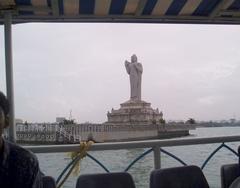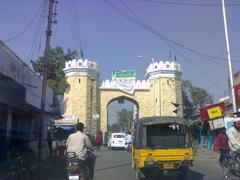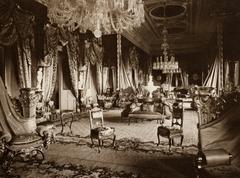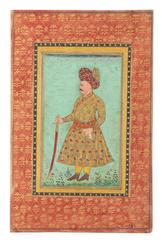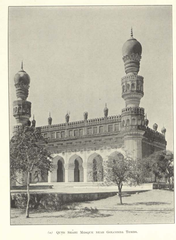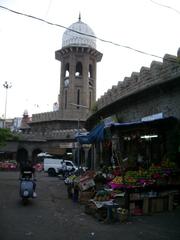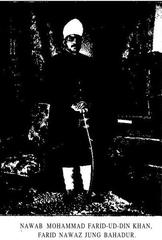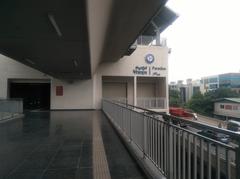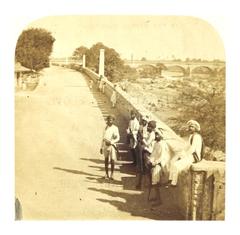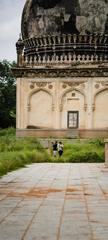Golconda Fort Visiting Hours, Tickets, and Guide to Hyderabad’s Historical Landmark
Date: 03/07/2025
Introduction
Golconda Fort stands as one of Hyderabad’s most celebrated historical monuments, epitomizing centuries of dynastic power, architectural ingenuity, and cultural vibrancy. Originally a modest mud fort built by the Kakatiya dynasty in the 12th century, it was later transformed into an imposing granite citadel under the Qutb Shahi rulers. Today, Golconda Fort is not only a protected monument but also a dynamic cultural hub, drawing visitors with its engineering marvels, acoustic wonders, and links to legendary diamonds such as the Koh-i-Noor and Hope Diamond. This comprehensive guide provides everything you need to plan your visit—including history, ticket prices, visiting hours, accessibility, and nearby attractions—ensuring an enriching experience at this iconic Hyderabad landmark (Incredible India, Avanigo, Wikipedia).
Table of Contents
- Introduction
- Historical Background
- Architectural Highlights
- Acoustic & Engineering Marvels
- Notable Structures
- Visiting Hours & Ticket Information
- Getting There & Accessibility
- Facilities & Amenities
- Experiences: Sound and Light Show & Festivals
- Nearby Attractions
- Visitor Tips & FAQs
- Conclusion
- Sources
Historical Background
Origins and Dynastic Significance
Golconda’s origins date to the 12th century, when the Kakatiya dynasty constructed a mud fort atop a granite hill—chosen for its strategic advantage in the Deccan region (Incredible India). The fort’s name, derived from “Golla” (shepherd) and “Konda” (hill), means “Shepherd’s Hill” in Telugu (Wikipedia). After the decline of the Kakatiyas, the Bahmani Sultanate took control in the 14th century, and in 1518, Sultan Quli Qutb-ul-Mulk declared independence, establishing Golconda as the capital of the Qutb Shahi dynasty (ZRN Farmhouse).
The Golden Age and Diamond Trade
Under the Qutb Shahis, Golconda Fort thrived as a hub of culture, administration, and especially commerce. Its diamond mines, such as Kollur, produced legendary gems like the Koh-i-Noor and Hope Diamond, making Golconda synonymous with immense wealth (Wikipedia). The city’s bustling markets also exported fine textiles worldwide.
The Mughal Siege and Legacy
Golconda’s formidable defenses withstood numerous attacks until 1687, when Mughal Emperor Aurangzeb finally captured the fort after an eight-month siege, marking the end of Qutb Shahi rule (Testbook). Despite this, Golconda remained an enduring symbol of Deccan heritage and resilience.
Architectural Highlights
Fort Layout & Defensive Design
Sprawling over a 400-foot-high granite hill with an outer wall stretching nearly 7–10 kilometers, Golconda Fort comprises three concentric enclosures. The outermost area housed the town, the intermediate zone surrounded the citadel gate, and the innermost section contained the royal residences (Avanigo). Eight massive gates, 87 bastions, and zigzag entryways with iron-studded doors exemplify its defensive sophistication (TravelTriangle).
Architectural Styles
Golconda Fort is a unique fusion of Hindu and Islamic aesthetics. Pointed arches, domes, and Persian-style minarets blend with carvings of peacocks and lions, reflecting the region’s multicultural legacy (Avanigo). The use of local granite and integration with the landscape demonstrate both practicality and artistry.
Acoustic & Engineering Marvels
The Whispering Walls
Golconda Fort is famed for its acoustic marvels. A clap below the dome at the Fateh Darwaza (Victory Gate) can be heard clearly at the Bala Hissar pavilion, nearly a kilometer away—an ingenious early warning system (Viacation, TravelTriangle). This effect is achieved through precise sound-channeling architecture and materials.
Water Management and Ventilation
The fort’s advanced water system used aqueducts, Persian wheels, and storage tanks to ensure a steady supply, even during sieges (TravelTriangle). Ventilation was optimized with strategically placed windows and water pits in the queens’ quarters, which also served as reflective surfaces and cooling elements (Avanigo).
Notable Structures
- Fateh Darwaza (Victory Gate): Main entrance, known for acoustics and decorated with defensive iron spikes and intricate carvings (TravelTriangle).
- Bala Hissar Gate: Located at the highest point; features lion and peacock motifs and offers panoramic views.
- Taramathi Gana Mandir & Premamathi Nritya Mandir: Pavilions associated with legendary performers, built atop natural rock outcrops (Avanigo).
- Jagadamba Mahakali Temple: Central to the Bonalu festival, where devotees offer decorated pots in gratitude to the goddess (The Daily Jagran).
- Royal Palaces, Gardens & Caves: Remnants of opulent palaces, lush gardens (now mostly in ruins), and secret passageways (MarathaBlogger).
Visiting Hours & Ticket Information
- Opening Hours: Daily, 9:00 AM to 5:30 PM (hyderabadtourism.travel, apnayatra.com)
- Light & Sound Show: Evening shows, typically from 6:30 PM (timings may vary; check official website)
- Entry Fees:
- Indian Citizens: ₹25
- Foreign Tourists: ₹300
- Children under 15: Free
- Still Camera: ₹25
- Light & Sound Show: ₹140 (Executive Adult), ₹110 (Executive Child), ₹80 (Normal Adult), ₹60 (Normal Child)
Note: Fees and timings are subject to change; always confirm in advance (hyderabadtourism.travel).
Getting There & Accessibility
- Location: Ibrahim Bagh, Hyderabad, Telangana 500008, India (hyderabadtourism.travel)
- By Air: Rajiv Gandhi International Airport (22–30 km away)
- By Train: Hyderabad Deccan (Nampally) Railway Station (11 km away)
- By Road: Accessible by taxi, auto-rickshaw, and frequent city buses; parking available (indiaongo.in)
- Metro: Nearest station is JNTU College Metro Station; taxis/autos connect to the fort
Accessibility: The fort involves extensive walking, stair climbing, and some steep slopes. While certain paths are wheelchair-friendly, most areas require moderate fitness. Assistance is recommended for visitors with mobility issues (MarathaBlogger).
Facilities & Amenities
- Parking: Ample, near the entrance
- Restrooms & Drinking Water: Available at designated locations
- Shops & Eateries: Small stalls offer snacks, water, and souvenirs
- Guided Tours: Professional guides and audio guides available on-site (bloggymaster.com)
- Security & Supervision: Families should supervise children due to steep drops and narrow stairs
Experiences: Sound and Light Show & Festivals
- Sound & Light Show: Narrates Golconda’s history with dramatic visuals and narration in multiple languages. Arrive early for the best seats, especially during peak season (letsgohyderabad.com).
- Bonalu Festival: Telangana’s vibrant state festival, celebrated with processions, music, dance, and offerings to the goddess Mahakali (Sakalam, Sakshi Post).
Nearby Attractions
- Qutb Shahi Tombs: Royal necropolis of the Qutb Shahi dynasty with domed monuments and landscaped gardens.
- Taramati Baradari: Historic sarai and cultural venue named after the famed courtesan.
- Charminar, Salar Jung Museum, Hussain Sagar Lake: Major Hyderabad landmarks easily combined with your Golconda visit (travelsetu.com).
Visitor Tips & FAQs
Tips for a Memorable Visit
- Best Time: September–March for mild weather; early mornings or late afternoons to avoid heat and crowds.
- Dress & Shoes: Light, comfortable clothing and sturdy walking shoes recommended.
- Hydration: Carry water bottles, especially during summer.
- Photography: Permitted, but check for restrictions and purchase permits where required (guidetour.in).
- Duration: Allocate 2–3 hours for a thorough visit.
Frequently Asked Questions
Q: What are the Golconda Fort visiting hours?
A: 9:00 AM–5:30 PM daily; evening sound and light shows have separate timings.
Q: How much are the tickets?
A: ₹25 (Indian adults), ₹300 (foreigners), children under 15 free; camera and show tickets extra.
Q: Is the fort wheelchair accessible?
A: Some pathways are accessible but most areas involve stairs and uneven terrain; assistance may be required.
Q: Are guided tours available?
A: Yes, at the entrance and through travel agencies.
Q: Can I visit other attractions the same day?
A: Yes, Qutb Shahi Tombs, Charminar, and other Hyderabad sites are nearby.
Visuals and Media


Conclusion
Golconda Fort is a living testament to Hyderabad’s rich heritage, architectural mastery, and vibrant culture. From its formidable defenses and acoustic wonders to its role in global diamond trade and spiritual traditions, the fort offers a multidimensional experience for every visitor. Plan ahead by checking visiting hours, ticket options, and accessibility, and enhance your exploration with guided tours and the evocative sound and light show. Combine your visit with nearby attractions for a comprehensive journey through Hyderabad’s illustrious past.
For official updates, ticket bookings, and more information, visit the Telangana Tourism official website. For curated travel guides and insider tips, download the Audiala app and follow us on social media.
Sources
- Incredible India
- Avanigo
- Wikipedia
- SZ Travel Blog
- TravelTriangle
- ZRN Farmhouse
- Testbook
- Ethereal Yana
- MarathaBlogger
- The Daily Jagran
- Sakalam
- Sakshi Post
- hyderabadtourism.travel
- indiaongo.in
- apnayatra.com
- letsgohyderabad.com
- guidetour.in
- bloggymaster.com
- travelsetu.com
